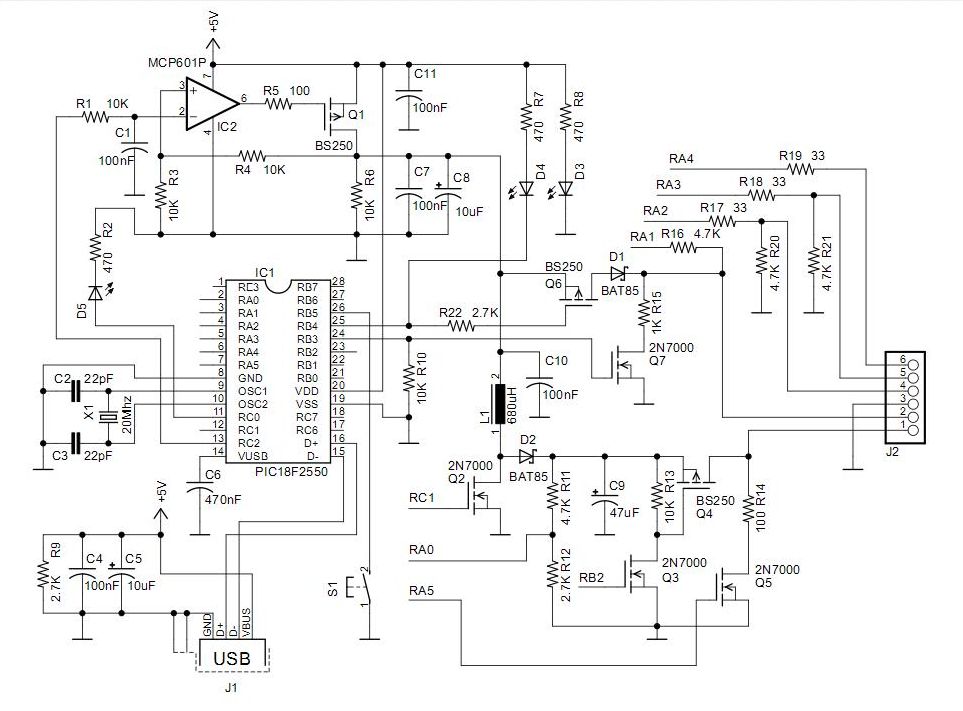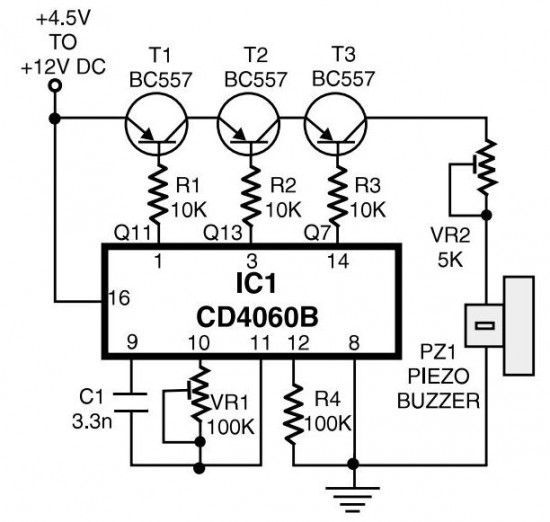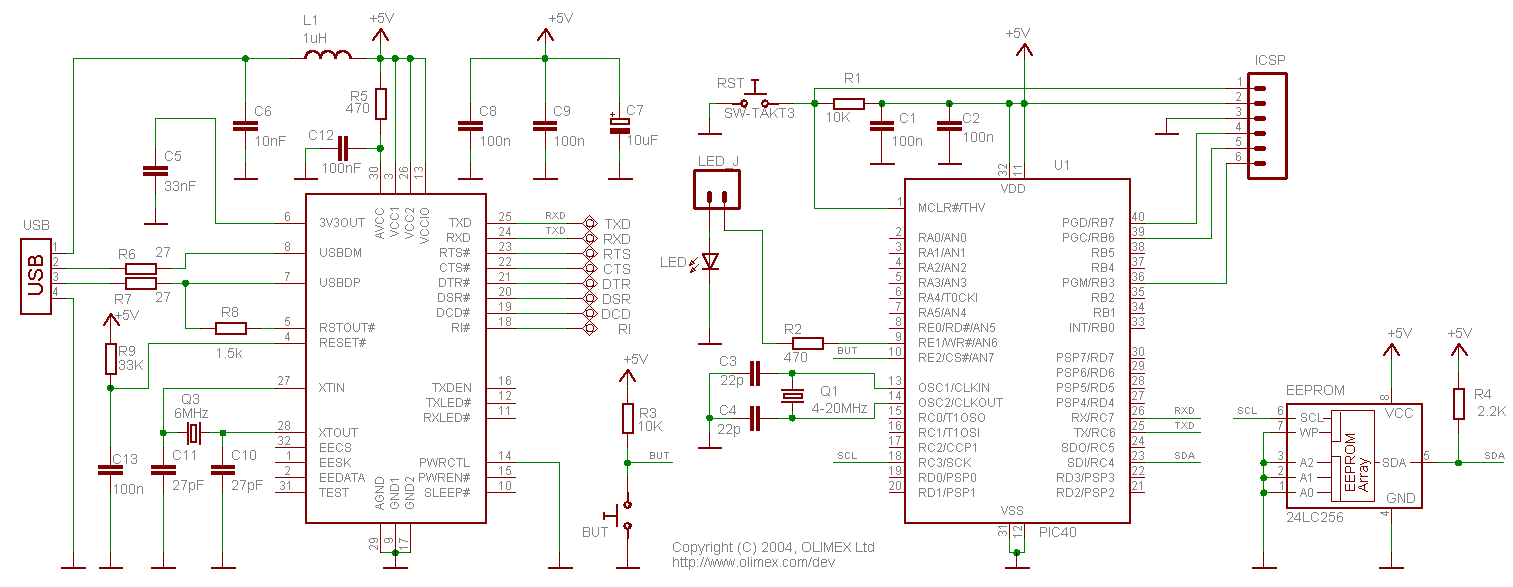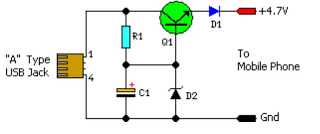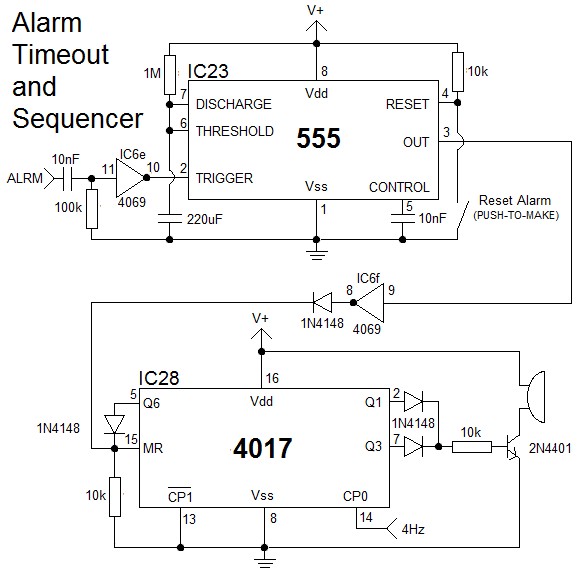
USB Live Oscilloscope: Clock Generator
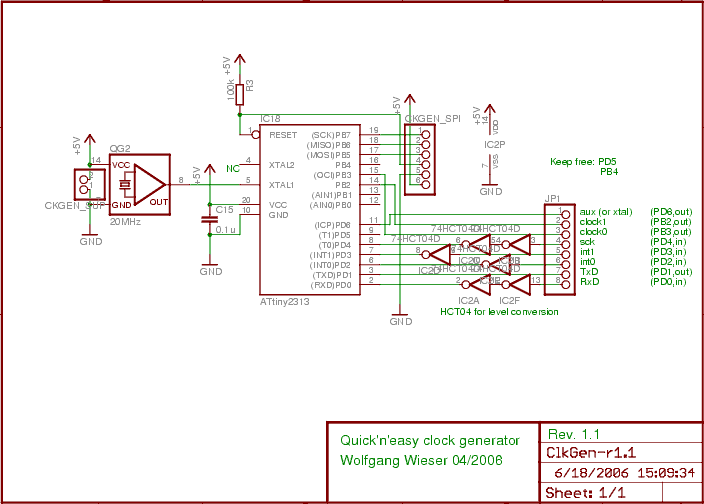
The design generates varying sampling clock write strobe pulses using an ATtiny2313 microcontroller from Atmel. For a 10MHz sampling clock, a 20MHz clock is required for the ATtiny2313, necessitating a power supply of 5V instead of 3.3V, which is typical for other logic components. HCT04 inverters were added for logic level translation of input pins, while output pins are compatible since both the VHC00 on the main board and the CY7C68013A on the USB-FX2 board have 5V tolerant inputs. The CKGEN_SPI 6-pin connector serves as the standard SPI in-system programming interface, allowing programming of the microcontroller via a USB-AtmelPrg programmer. JP1 connects to the main board. The 8051 controller on the USB-FX2 board can program the sampling clock by setting INT1 HIGH, transferring commands through the serial lines SCK and RxD, and reading back status via TxD (synchronized by SCK) before setting INT1 LOW again. The clock generator consistently outputs a 10MHz sampling clock on the clock0 output pin, which drives the AD converter and latches at a constant rate. This clock also serves as the USB_IFCLK for the USB-FX2, requiring it to maintain a stable frequency without glitches or missing pulses. Debugging revealed that a minor glitch in the USB_IFCLK caused by the ATtiny2313 firmware while synchronizing the interface clock with write strobes interrupted data transmission over the USB link. Different sampling rates are achieved through varying write strobes on the clock1 pin (USB_RDY1, which is SLWR in slave FIFO mode), allowing selective committing of samples to the FIFO and USB link. For full 10MS/s, clock1 is held LOW to commit all samples; for 5MS/s, it is LOW at every second low-to-high transition of the sampling clock; for 1MS/s, it is LOW at every tenth transition, and so on. The clock generator requires firmware to be downloaded to its flash storage prior to integration with the main board. Developing this firmware involves precise timing to ensure synchronization between the sampling clock (generated by an on-chip timer/counter) and the write strobes.
The circuit design employs an ATtiny2313 microcontroller, which operates at 20MHz to generate a stable 10MHz sampling clock. This clock is critical for driving an analog-to-digital (AD) converter and latches, ensuring consistent data acquisition. The use of HCT04 inverters facilitates the necessary level shifting, permitting integration with other digital logic that operates at lower voltage levels. The CKGEN_SPI connector is essential for in-system programming, providing a straightforward means to upload firmware to the ATtiny2313, which is responsible for managing the clock generation and write strobe timing.
The sampling clock's stability is paramount, as it also serves as the USB interface clock (USB_IFCLK) for the USB-FX2 board. Any fluctuation in this clock signal could disrupt data flow, as evidenced by previous debugging efforts that identified glitches caused by improper synchronization in the firmware. The design's flexibility allows for various sampling rates by controlling the write strobe signals on clock1, enabling dynamic adjustment of data throughput as dictated by application requirements.
The firmware development process is critical, requiring meticulous attention to timing specifications to ensure that the sampling clock remains synchronized with the write strobes. This synchronization is achieved through the use of an on-chip timer/counter, which must be precisely calibrated to maintain the integrity of the data being processed. Overall, this circuit configuration provides a robust solution for generating variable sampling clock write strobe pulses while ensuring compatibility with existing digital logic and maintaining high data integrity over USB.Produce the varying sampling clock write strobe pulses. So, I settled with this semi-optimal but working design applying an ATtiny2313 microcontroller from Atmel. For a 10MHz sampling clock, I need a 20MHz clock for the ATtiny2313and hence it needs to be powered at 5V instead of 3.
3V like all the other logic around. So, I had to add these HCT04 inverters for logic level translation of input pins; output pins are no big deal since both the VHC00 on the main board and the CY7C68013A on the USB-FX2 board have 5V tolerant inputs. The CKGEN_SPI 6-pin connector is the standard SPI in-system-programming connector so that the microcontroller can be programmed by my USB-AtmelPrg programmer.
JP1 is the connection to the mainboard. The 8051 controller on the USB-FX2 board can program the sampling clock by taking INT1 HIGH, then transferring a command via the serial lines SCK and RxD while reading back status via TxD (also synchronized by SCK) and then taking INT1 LOW again. The clock generator outputs a constant 10MHz sampling clock on the clock0 output pin. This clock will drive the AD converter and latches at constant 10MHz at any time. Since this is also the interface clock for the USB-FX2 (USB_IFCLK), we may never change the frequency and even may never have any glitch or missing pulse.
(Yes, I debugged the circuit for a whole day until discovering that a tiny glitch in the USB_IFCLK introduced by the ATtiny2313 firmware while synchronizing the interface clock with the write strobes, made the FX2 stop sending data over the USB link!) Different sampling rates are accomplished by different write strobes on the clock1 pin (USB_RDY1 which is SLWR in slave fifo mode) thereby only committing certain samples to the FIFO and hence to the USB link. So, for full 10MS/s, clock1 is simply pulled LOW, committing all samples, for 5MS/s, it is LOW at every second low-to-high transition of the sampling clock, for 1MS/s it`s the same for evey 10th low-to-high transition, etc.
Since it applies a microcontroller, the clock generator needs some firmware wich has to be downloaded onto its flash storage before plugging it into the mainboard. Writing this firmware was not as simple as it may seem since the timings have to be exactly right and the sampling clock (provided by an on-chip timer/counter) must be kept in sync with the write strobes.
🔗 External reference
The circuit design employs an ATtiny2313 microcontroller, which operates at 20MHz to generate a stable 10MHz sampling clock. This clock is critical for driving an analog-to-digital (AD) converter and latches, ensuring consistent data acquisition. The use of HCT04 inverters facilitates the necessary level shifting, permitting integration with other digital logic that operates at lower voltage levels. The CKGEN_SPI connector is essential for in-system programming, providing a straightforward means to upload firmware to the ATtiny2313, which is responsible for managing the clock generation and write strobe timing.
The sampling clock's stability is paramount, as it also serves as the USB interface clock (USB_IFCLK) for the USB-FX2 board. Any fluctuation in this clock signal could disrupt data flow, as evidenced by previous debugging efforts that identified glitches caused by improper synchronization in the firmware. The design's flexibility allows for various sampling rates by controlling the write strobe signals on clock1, enabling dynamic adjustment of data throughput as dictated by application requirements.
The firmware development process is critical, requiring meticulous attention to timing specifications to ensure that the sampling clock remains synchronized with the write strobes. This synchronization is achieved through the use of an on-chip timer/counter, which must be precisely calibrated to maintain the integrity of the data being processed. Overall, this circuit configuration provides a robust solution for generating variable sampling clock write strobe pulses while ensuring compatibility with existing digital logic and maintaining high data integrity over USB.Produce the varying sampling clock write strobe pulses. So, I settled with this semi-optimal but working design applying an ATtiny2313 microcontroller from Atmel. For a 10MHz sampling clock, I need a 20MHz clock for the ATtiny2313and hence it needs to be powered at 5V instead of 3.
3V like all the other logic around. So, I had to add these HCT04 inverters for logic level translation of input pins; output pins are no big deal since both the VHC00 on the main board and the CY7C68013A on the USB-FX2 board have 5V tolerant inputs. The CKGEN_SPI 6-pin connector is the standard SPI in-system-programming connector so that the microcontroller can be programmed by my USB-AtmelPrg programmer.
JP1 is the connection to the mainboard. The 8051 controller on the USB-FX2 board can program the sampling clock by taking INT1 HIGH, then transferring a command via the serial lines SCK and RxD while reading back status via TxD (also synchronized by SCK) and then taking INT1 LOW again. The clock generator outputs a constant 10MHz sampling clock on the clock0 output pin. This clock will drive the AD converter and latches at constant 10MHz at any time. Since this is also the interface clock for the USB-FX2 (USB_IFCLK), we may never change the frequency and even may never have any glitch or missing pulse.
(Yes, I debugged the circuit for a whole day until discovering that a tiny glitch in the USB_IFCLK introduced by the ATtiny2313 firmware while synchronizing the interface clock with the write strobes, made the FX2 stop sending data over the USB link!) Different sampling rates are accomplished by different write strobes on the clock1 pin (USB_RDY1 which is SLWR in slave fifo mode) thereby only committing certain samples to the FIFO and hence to the USB link. So, for full 10MS/s, clock1 is simply pulled LOW, committing all samples, for 5MS/s, it is LOW at every second low-to-high transition of the sampling clock, for 1MS/s it`s the same for evey 10th low-to-high transition, etc.
Since it applies a microcontroller, the clock generator needs some firmware wich has to be downloaded onto its flash storage before plugging it into the mainboard. Writing this firmware was not as simple as it may seem since the timings have to be exactly right and the sampling clock (provided by an on-chip timer/counter) must be kept in sync with the write strobes.
🔗 External reference
